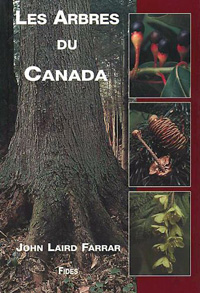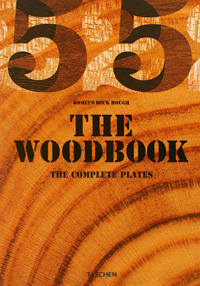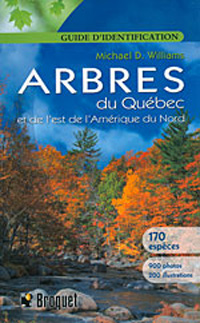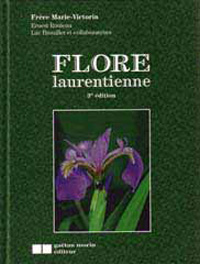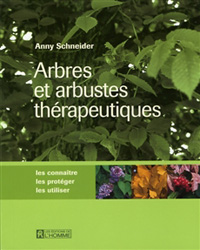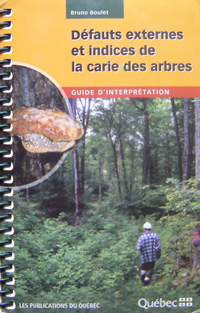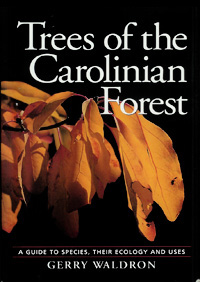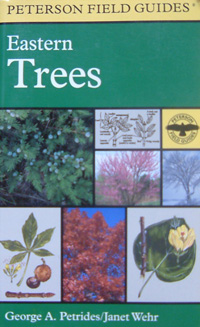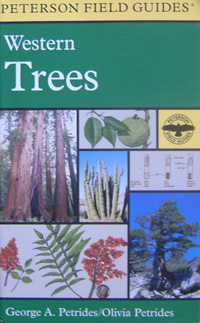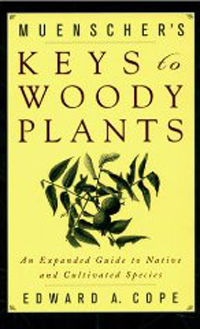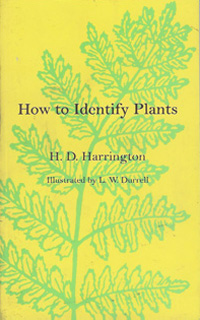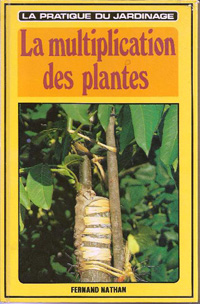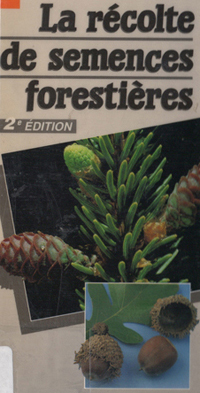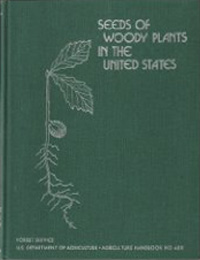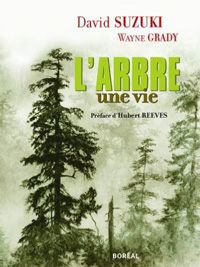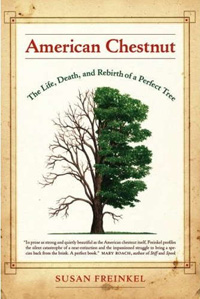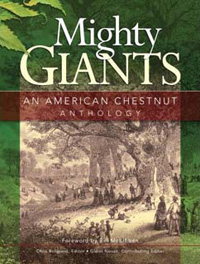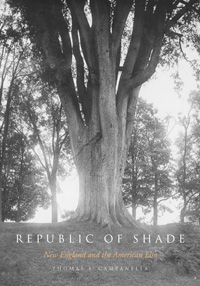Ressources littéraires
La section Ressources littéraires regroupe ici plusieurs livres sur les arbres et sur la flore en général. La grande majorité de ces livres traite de la flore nord-américaine et plus souvent qu'autrement, c'est celle de l'est de l'Amérique du Nord qui est considérée (celle du Québec ou flore laurentienne). Néanmoins, l'ouest de l'Amérique du Nord est quelque peu abordé, tout comme l'est le reste du monde.
Dans cette section, pour chaque livre ou document littéraire, on retrouve une photo, une description et une bibliographie de l'oeuvre en question. Dans un premier temps, ces ressources littéraires sont classées selon le sujet qu'elles abordent et, dans un second temps, selon la langue utilisée par l'auteur(e). À noter que seules les ressources francophones et anglophones sont ici considérées.
Cliquez sur l'image de la page couverture de l'oeuvre pour l'acheter via le site amazon.com (dans la plupart des cas).
- Livres de description et d'identification des végétaux
Français
Anglais - Livres traitant des semences, des semis et de la multiplication des végétaux
Français
Anglais - Livres consacrés aux sciences forestières (conservation, aménagement, gestion, création des forêts)
Français
Anglais - Récits floristiques
Français
Anglais - Revues scientifiques
Français
Anglais
Livres de description et d'identification des végétaux (Français)
|
Voici le plus complet des ouvrages jamais parus sur les arbres du Canada et du nord des États-Unis. On y trouve décrites au-delà de 300 espèces, indigènes ou introduites. Conçu pour le naturaliste amateur comme pour le forestier professionnel ou l'architecte paysagiste, ce guide contient : 580 photos couleurs et 1600 dessins de caractères utiles pour l'identification ; 136 cartes illustrant l'aire de répartition des essences au Canada et au nord des États-Unis, jusqu'au sud de la Pennsylvanie et au nord de la Californie ; une nouvelle méthode d'identification dans laquelle tous les arbres sont répartis en 12 groupes d'après la forme des feuilles et leur disposition le long des rameaux; des clefs pour l'identification des espèces en été et en hiver. Cette édition entièrement nouvelle s'appuie sur le très populaire ouvrage Arbres indigènes du Canada qui a été le guide d'identification incontournable depuis des décennies. Résumé officiel de la couverture arrière du livre |
|||
|
|||
|
Pour son 25e anniversaire, la maison Taschen reproduit en fac-similé les pages des quatorze volumes originaux rassemblés par Romeyn Beck Hough entre 1888 et 1913. Cet ouvrage était devenu une référence pour l'étude des bois et des arbres. Chaque essence est étudiée dans trois coupes : transversale, radiale et tangentielle, ce qui permet de saisir toute la richesse de couleur et le grain des bois proposés. Des portraits de chaque essence, avec l'origine géographique et les principales caractéristiques, sont enrichis de lithographies de Charles Sprague Sargent. Une très belle collection d'essences de bois, dont certaines espèces sont devenues très rares ou ont disparu. Résumé du livre par evene.fr |
|||
|
|||
|
Identifiez les arbres en toute saison, et non seulement lorsqu'ils sont remplis de feuilles. C'est ce que vous propose ce guide éprouvé sur le terrain grâce aux nombreuses photos couleur présentant l'écorce, les motifs de branches, les fruits, les fleurs ou les noix des arbres, ainsi que leur aspect d'ensemble et la couleur et la forme de leurs feuilles. Toutes ces photos ont été choisies avec soin pour représenter les arbres à chacune des saisons de l'année. Les endroits où l'on peut trouver ces arbres ainsi que les caractéristiques d'identification de chaque espèce sont décrits en détail dans les textes d'accompagnement. Réalisé de manière à pouvoir être consulté facilement sur le terrain ou à la maison, ce guide comprend des clefs d'identification faciles à utiliser qui vous permettront de trouver le nom d'un arbre simplement en feuilletant quelques pages. Michael D. Williams est un expert forestier qui possède une grande expérience de la forêt sous tous ses aspects. Au cours de sa longue carrière de recherches, il a beaucoup travaillé sur le terrain. Il est réputé pour sa capacité à expliquer les concepts complexes de la foresterie en termes simples et accessibles. Résumé officiel de la couverture arrière du livre |
|||
|
|||
|
«La Flore laurentienne, dont voici une troisième édition, demeure une oeuvre maîtresse de l’Occident entre-deux-guerres (1919-1939). Aucune publication analogue ne s’élève alors aussi bien hors de la sécheresse des nomenclatures et des descriptions encyclopédiques. Chez Marie-Victorin, la sécurité et la crédibilité de l’information y est partout doublée de commentaires phylogénétiques, phytogéographiques et écologiques, et également d’informations historiques et ethnographiques. Ces notes, loin d’être marginales, sont une invitation à prolonger le regard au delà de l’identification pour rejoindre les fonctions de chaque plante, pour valoriser le rôle unique et irremplaçable qu’elle joue dans la nature et qui est tour à tour amplifié et menacé par l’homme. Dans les années 1990, où la biodiversité est une des préoccupations dominantes des biologistes, les ouvertures que nous offre Marie-Victorin sont les bienvenue.» Extrait de l’avant-propos de Pierre Dansereau |
|||
|
|||
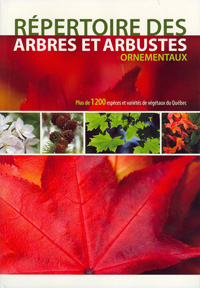 PELLERIN, Gervais, dir. 2005. Répertoire des arbres et arbustes ornementaux, 3ième édition. Montréal: Hydro Québec, Unité environnement, Direction Maintenance et Expertise. 547 p. Le Répertoire des Arbres et Arbustes Ornementaux dresse l'inventaire de plus de 1200 espèces et variétés de végétaux que l'on trouve au Québec. C'est un ouvrage de référence à la portée de tous, qui s'adresse tout aussi bien aux amateurs d'horticulture qu'aux spécialistes du domaine. Vous désirez en savoir plus sur un arbre en particulier? Consultez la fiche correspondante et vous aurez toutes les réponses à vos questions : la couleur de ses feuilles à l'été ou à l'automne, celle de ses fleurs, sa vitesse de croissance, sa résistance aux maladies ou au sel de déglaçage et même l'attrait qu'il provoque chez les oiseaux. Et comme vous connaîtrez également la ramification de ses racines et sa taille à maturité, vous ne serez pas pris au dépourvu. Vous pourrez prévoir d'avance les risques qu'il pourrait présenter pour votre jardin, votre maison ou encore le réseau de distribution d'électricité d'Hydro-Québec. De nombreux spécialistes chevronnés ont participé à l'élaboration de ce répertoire. Ils ont mis en commun leur savoir-faire pour faire en sorte qu'il soit à la fois facile à consulter, exhaustif et pratique. À cette fin, ils ont analysé à la loupe les caractéristiques et le comportement de chaque espèce observée dans les diverses régions du Québec. À vous maintenant de mettre vos connaissances à l'épreuve. Résumé officiel de la couverture arrière du livre |
|||
|
|||
|
Édité par l’Association forestière des Cantons de l’Est, ce guide de mise en valeur s’adresse aux aménagistes forestiers du territoire que sont les conseillers forestiers, les entrepreneurs forestiers, les propriétaires de boisés privés et les municipalités. Il permettra à ces derniers de prendre des décisions éclairées pour valoriser l’aménagement forestier des feuillus nobles en accord avec les exigences écologiques de chaque espèce. Le guide traite de la gestion écologique et économique de vingt feuillus en plantation, en enrichissement et en peuplement naturel. Une carte du potentiel de production est également incluse. Compte tenu de la réponse à long terme des arbres, l’aménagiste doit saisir l’importance du choix des essences et du site afin d’optimiser la réussite. Résumé de l'Association Forestière du sud du Québec |
|||
|
|||
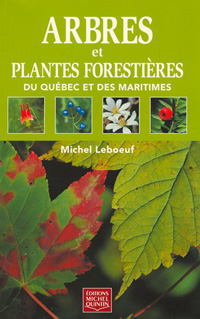 LEBOEUF, Michel. 2007. Arbres et plantes forestières du Québec et des Maritimes. Waterloo: Éditions Michel Quintin. 391 p. Voici le guide complet permettant d'identifier tous les arbres et les autres végétaux forestiers communs du Québec et des Maritimes: 200 espèces traitées (arbres, arbustes, plantes herbacées, fougères, prêles, lycopodes, etc.) ; plus de 600 photos couleur ; des cartes de répartition des arbres et de nombreuses illustrations ; des rubriques concises et complètes sur toutes les plantes ; des clefs d'identification claires et pratiques. La première partie de l'ouvrage traite de l'écologie des forêts ; la seconde décrit la plupart des espèces végétales courantes de nos bois. Résumé officiel de la couverture arrière du livre |
|||
|
|||
|
Arbre à palabres, arbre à souhaits, arbre-pilier, arbre repère, arbre nourricier, arbre semencier, arbre généalogique et arbre guérisseur, arbre de vie et arbre des morts, l'arbre est un symbole sacré présent dans l'histoire de tous les peuples de la terre. Sources d'enchantement et de repos, les arbres et la forêt sont aussi des ressources vitales pour la plupart des êtres vivants en raison de l'oxygène, de la chaleur, de l'humidité, de la nourriture et de l'humus qu'ils génèrent. Leur utilité s'étend à de multiples qualités thérapeutiques assurées par de précieuses composantes biochimiques confirmées aujourd'hui par la science, mais reconnues depuis toujours par l'herboristerie traditionnelle. Ce traité explore toutes les facettes des liens entre les arbres et les humains, de l'imaginaire universel à l'état de santé de la forêt mondiale.Il expose surtout les valeurs nutritives et thérapeutiques méconnues des arbres les plus familiers, sans oublier des pistes pour les protéger et les utiliser. Ce guide propose un regard nouveau et unique sur ces merveilleux souverains végétaux. Résumé officiel de la couverture arrière du livre |
|||
|
|||
 LAMOUREUX, Gisèle et LAROSE, Roger, , 2002. Flore printanière, [s.l.]: FLEURBEC. 576 p. Avec le printemps, la vie explose dans les bois, où s’épanouissent la plupart des plantes printanières d'ici. Vous ne les trouverez nulle part ailleurs au monde, car elles croissent uniquement dans les forêts du nord-est de l'Amérique. Plusieurs grandissent pendant 10, 15 ou 25 ans avant de produire une première fleur, mais elles vivent centenaires ou bicentenaires! Ce guide plonge au cœur même de leur vie fascinante. Il incite à respecter les plantes sauvages forestières et permet de comprendre pourquoi il ne faut pas les cueillir. Flore printanière constitue une mise à jour enrichie de Plantes sauvages printanières, par Gisèle Lamoureux et collaborateurs, paru en 1975. Textes et photographies entièrement nouveaux, ajout d’une trentaine d’espèces. Résumé officiel du livre |
|||
|
|||
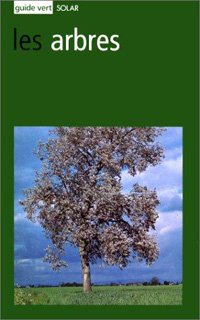 DURAND, Raymond, 2000. Les arbres, [s.l.]: Solar. 379 p. Un guide pour tout savoir sur les arbres du monde entier : port, feuillage, couleur, terrain... 298 espèces d'arbres, du plus familier au plus rare. Plus de 300 photos couleurs. Résumé du livre par Solar.fr |
|||
|
|||
 BOULET, Bruno, 2003. Les champignons des arbres de l'est de l'Amérique du Nord, [s.l.]: Publications du Québec. 748 p. Avec plus de 500 photos couleurs, ce guide d'identification, le plus complet en son genre, lève le voile sur le monde fabuleux et méconnu des champignons forestiers. Les champignons des arbres constituent un champ d'observation particulièrement riche, car ils sont à la fois nombreux et diversifiés. Alors, comment s'y retrouver parmi les milliers d'espèces que recèlent nos forêts? Ce guide d'identification, le plus complet en son genre, lève le voile sur le monde fabuleux et méconnu des champignons forestiers. Il propose un système d'identification original basé sur des critères visuels et offre des conseils précieux pour aider à chercher, à cueillir, à préserver et à photographier les diverses espèces. Un lexique détaillé et des index multilingues facilitent la consultation. Les fiches signalétiques et les photographies des champignons forment le coeur de l'ouvrage. Elles fournissent une description précise de la morphologie, des traits distinctifs et de l'habitat de chaque espèce. Fruit de quinze années de recherche, cet ouvrage fascinera non seulement les mycologues amateurs, mais aussi les forestiers et les biologistes qui s'intéressent à l'écologie des champignons, aux maladies des arbres et à l'aménagement forestier. Résumé officiel du livre |
|||
|
|||
|
Ce guide vise à appuyer la formation des marteleurs en leur permettant de reconnaître les tiges en perdition à récupérer en priorité lors des coupes partielles réalisées en forêt. Il sert aussi à distinguer les arbres servant d’habitat pour la faune et les arbres dangereux pour la sécurité des travailleurs forestiers, des randonneurs et des personnes qui fréquentent les boisés et les parcs suburbains. D’abord conçu pour une consultation sur le terrain, il fournit aux ingénieurs, aux techniciens et aux gardes forestiers les fondements et les informations techniques pertinentes pour diagnostiquer les défauts des arbres et en évaluer les effets sur leur vigueur à long terme. Résumé officiel du livre |
|||
|
Livres de description et d'identification des végétaux (Anglais)
|
This book identifies the 73 unique tree species of the Carolinian Zone and offers advice on how to identify, preserve, use and propagate each species. It also includes important notes on the qualities of each specie's wood, its natural enemies, and its value to wildlife. The unusually lush Carolinian Zone is the northernmost range of the lofty Tuliptree, the elusive Pawpaw, the flamboyant Black Gum, the brooding Butternut, the Magnolia, the Cucumbertree and many more deciduous species. This temperate zone is rich in human population, too. In this remarkable book, arborist Gerry Waldron explains how we can protect and encourage these trees despite urban encroachment. Résumé officiel de la couverture arrière du livre |
|||
|
|||
|
This field guide features detailed descriptions of 455 species of trees native to eastern North America, including the Midwest and the South. The 48 color plates, 11 black-and-white plates, and 26 text drawings show distinctive details needed for identification. Color photographs and 266 color range maps accompany the species descriptions. Résumé du livre par Amazon.com |
|||
|
|||
|
An authoritative book that includes every tree that grows wild in western North America, including Alaska. Using the unique system of identification employed in the author's other tree books, the 387 trees of the region are divided into six major groups according to conspicuous characteristics. Within those categories, trees that look alike are brought together and compared in text and illustration, regardless of whether they are related or not. The color plates, beautifully painted by Olivia Petrides, the author's daughter and Adjunct Associate Professor at the School of the Art Institute of Chicago, emphasize details that may not be present or clearly visible in a photograph. Differences between trees that resemble each other are also listed in distinctive comparison charts. With range maps, keys, descriptions, and illustrations, the user can identify trees at any season, even when without leaves. Technical terminology is converted into plain English. The values of trees and their use by wildlife, Native Americans, and campers also are discussed. Résumé officiel du livre |
|||
|
|||
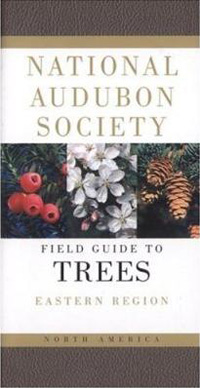 NATIONAL AUDUBON SOCIETY, 1980. Field Guide to North American Trees: Eastern Region, New York: Knopf. 716 p. For the untrained observer, it can be quite a challenge to sort out the many trees that make up a stand of older forest in, say, New England or the Ozarks. This well-illustrated guidebook, covering 364 species, comes to the rescue with photographs organized in several ways: by, for example, the shape of the leaf or needle, by the fruit, by the flower or cone, and by autumn coloration. Following one visible characteristic or another, the reader can narrow the range of possibilities, then turn to an informative text that describes a tree's physical characteristics, habitat, and range. Many of the species covered are relatively rare, such as the "stinking cedar" of the Georgia-Florida border ; others are locally abundant, such as the paper birch of the boreal forest, used to make ice-cream sticks ; still others, such as the smooth sumac, are widespread. The guidebook also covers ornamentals introduced from other continents, such as the Chinese privet and Mahaleb cherry. Résumé du livre par Amazon.com |
|||
|
|||
 NATIONAL AUDUBON SOCIETY, 1980. Field Guide to North American Trees: Western Region, New York: Knopf. 640 p. More than 300 species of trees are found in the United States and Canada west of the Rocky Mountains, some introduced from other continents but many native to the region. This handsome guidebook covers them all, with photographs that enable identification by easily discernible characteristics: by, for example, the shape of the leaf or needle, by the fruit, or by the flower or cone. The photographs are linked to texts that describe a tree's physical characteristics, habitat, and range. Some of the trees covered in this volume are exceedingly rare, such as the Monterey pine ; others are locally abundant but limited in range, such as the Joshua tree ; still others, such as the quaking aspen, are widespread. This guidebook is an essential addition to any western outdoor enthusiast's collection. Résumé du livre par Amazon.com |
|||
|
|||
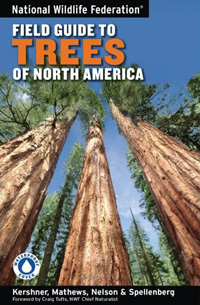 KERSHNER, Bruce, 2008. Field Guide to Trees of North America, New York: Sterling. 528 p. The Jeffrey Pine, Coconut Palm, Staghorn Sumac, and Western Hemlock: this single, portable volume features these, plus more than 700 other tree species and varieties, with special emphasis on their leaves, bark, fruits, and flowers. More than 2,000 stunning images show these trees in their natural habitats. Other features include: a unique identification tip for each tree ; range maps showing distribution in North America ; How to Identify a Tree section ; a detailed glossary of tree parts and leaf, fruit, flower, and bark types ; essays on ecology, conservation, and North America’s important forest types ; plus a complex species and quick-flip indexes. The guide’s unique waterproof cover makes it especially valuable for use in the field. Résumé officiel du livre |
|||
|
|||
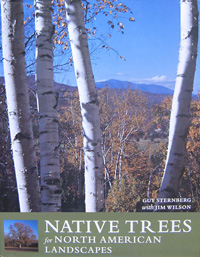 STERNBERG, Guy et W. WILSON, James et WILSON, Jim, 2004. Native Trees for North American Landscapes, Portland: Timber Press, Inc. 552 p. As our environment becomes increasingly fragile, the benefits of utilizing and preserving native trees become increasingly important. For the home gardener and horticulture professional alike, recognizing indigenous species versus exotic cultivars is only the first step on a journey of education and appreciation. With Sternberg and Wilson as guides, the vast quantity and nearly infinite variety of native plant material found from the Atlantic coast to the Continental Divide is explored in precise and practical detail in this accessibly readable account of more than 650 species and varieties. Balancing objective data with subjective opinion, Sternberg shares essential information, such as how to successfully avoid construction damage, before devoting the core of the book to an exceptionally comprehensive menu of native trees. Alphabetically arranged by botanic name, each profile is packed with valuable cultural and descriptive information. Supported by more than 500 color photographs, convenient at-a-glance tree selection lists, and directories of Internet and Natural Heritage contacts, Sternberg's authoritative guide is an indispensable addition to any landscape library. Résumé de Carol Haggas, American Library Association |
|||
|
|||
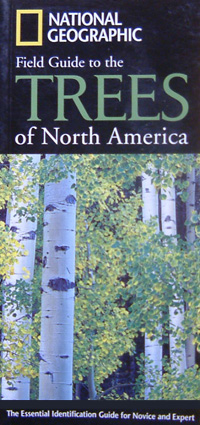 RUSHFORTH, Keith et HOLLIS, Charles, 2006. Field Guide to Trees of North America, Washington, D.C: National Geographic. 272 p. Ideal for backpacks and back pockets alike, this indispensable reference makes it easy to identify any tree commonly encountered between the Canadian Arctic and Mexico and from the Atlantic to the Pacific—more than 350 species in all. It's a natural for birders, hikers, and other outdoorsy types, but even confirmed urbanites will find plenty of information on city trees as well. Concise yet comprehensive, the book's clear, methodical approach enables anyone to recognize trees at a glance. Developed in consultation with botanists from The Royal Botanic Gardens, Kew, and Cornell University's renowned Bailey Hortorium, it separates species into two fundamental types: conifers and broad-leaved, then organizes them into genera based on common characteristics, presenting each in its presumed order of evolution. Major differences between species groups are explained, with advice on which parts of a tree to examine when a closer look is required. More than 1,000 annotated illustrations depict the height, shape, foliage, buds and seed of each species, with trees bearing a strong resemblance shown side by side to highlight their distinctive differences. The accompanying text and system of symbols provide the important details on features and habitat essential to quick, reliable identifications, while graphical keys indicate genus and species, listing both scientific and common names. The guide also includes a map charting tree hardiness and distribution based on widely recognized climactic zones ; general information about individual species traits and history, a glossary ; and more. Résumé officiel du livre |
|||
|
|||
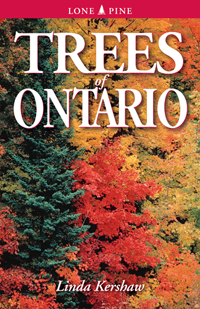 J. KERSHAW, Linda, 2001. Trees of Ontario, Edmonton: Lone Pine Pub. 240 p. Trees of Ontario is a comprehensive guide to all native and naturalized trees and tall shrubs in the province. It includes notes of interest on edible fruits and on human and wildlife uses of the trees. 574 colour photos and illustrations show each tree's bark, leaves, flowers, fruits or cones, and overall shape. Identification is easy with tips for distinguishing similar species. You'll find range maps and habitat descriptions, as well as illustrated keys based on leaf, flower, fruit and winter characteristics. The book also features the origins of names, French names for species, as well as an illustrated glossary. Keep this handy book in your backpack for easy reference on hikes and walks, or put it on your cottage bookshelf. Résumé officiel du livre |
|||
|
|||
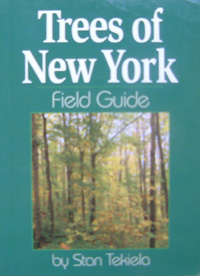 TEKIELA, Stan, 2006. Trees of New York, Cambridge: Adventure Publications. 260 p. Tree identification can be easy and enjoyable for everyone! This field guide features professional, full-page photos and comprehensive, accessible information about each tree's leaves or needles, bark, mature size, fall color, state-specific range map and more. The author's notes include helpful identification tips and interesting facts. The book covers more than 115 common trees and is a great size for use in the field. Résumé officiel du livre |
|||
|
|||
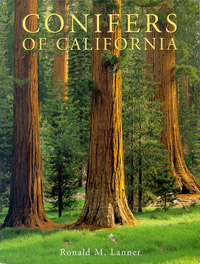 M. LANNER, Ronald, 1999. Conifers of California, Los Olivos: Cachuma Press. 274 p. Conifers of California is the first book entirely devoted to the state's native cone-bearing trees and shrubs. Richly illustrated, it serves as both a natural history and field guide. Each species' narrative is accompanied by a full-page color botanical illustration, photographs from the wild, detailed indentification information, and a range map. California is home to more than 50 native species of pines, first, spruces, junipers hemlocks, and other conifers. "Conifers of California" covers the state's world-renowned cone-bearers, such as coast redwood, giant sequoia, and bristlecone pines, and also features its many other rare and unusual conifers, such as Torrey pine, Santa Lucia fir, and Brewer spruce. (Ce résumé s'applique à l'édition reliée) Résumé officiel du livre |
|||
|
|||
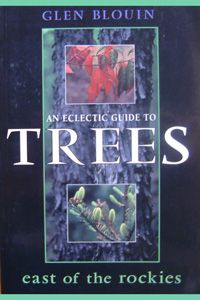 BLOUIN, Glen, 2001. An Eclectic Guide to Trees East of the Rockies, Erin: Boston Mills Press. 220 p. "The scope of this book is biological rather than political," writes author Glen Blouin. "It is neither a Native Trees of Canada, nor a Native Trees of the United States. Trees are apolitical characters. They do not recognize international boundaries. They grow where they are comfortable, where the climate and soils suit them." This one-of-a-kind book is certainly an excellent guide to identifying the almost fifty major tree species east of the Rockies by their components (size, wood, bark, leaf, flower, fruit, twig, etc.), but it goes far beyond such basic details. It also provides:
"This thoughtful book by Glen Blouin nicely explores the broader significance of tree species found east of the Rockies, in Canada and the United States. It expands on all that interesting information that is only touched upon through a sentence or two in standard field guides ... Every forest is a treasure house of such knowledge if we only have a companion such as this book to help us gain access." From the foreword by Monte Hummel, President, World Wildlife Fund, Canada |
|||
|
|||
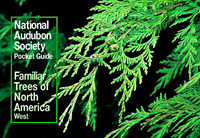 NATIONAL AUDUBON SOCIETY, 1987. Familiar Trees of North America: West, New York: Knopf. 192 p. Take a walk through the your neighborhood, the park, or the woods and learn more about the trees you pass by every day! This beautiful field guide is great for nature enthusiasts of all ages. Includes common and scientific names, habitat, range, leaf types, fruit and nut types, families and a glossary of common terms. Résumé de imaginechildhood.com |
|||
|
|||
|
This major expansion and revision of W. C. Muenscher's popular reference work brings a wealth of botanical knowledge up to date in an easy-to-access format. Muenscher's Keys to Woody Plants enables its users to identify trees and shrubs in all seasons by means of diagnostic field characteristics including leaves, fruits, buds, twigs, and bark. The new and expanded version of this classic indentification tool for horticulturists, botanists, foresters, and ecologists treats more than 300 genera and more than 1100 species of woody plants found in the north-eastern United States. This is more than double the number covered by Muenscher's sixth edition and includes almost 600 cultivated species. Edward A. Cope's revision
Résumé officiel de la couverture arrière du livre |
|||
|
|||
|
First issued in 1957 by Swallow Press, this classic guide to the art of plant identification is now familiar to an entire generation of students. Harrington who was Professor of Botany and Curator of the Herbarium at Colorado State University, clear and carefully organized textbook provides gives step-by-step instructions and definitions to aid in recognition and classification of plants. The 1996 edition has been reset and its 533 drawings and illustrated glossary have been digitally enhanced for clarity. Résumé officiel de la couverture arrière du livre |
|||
|
Livres traitant des semences, des semis et de la multiplication des végétaux (Français)
Livres traitant des semences, des semis et de la multiplication des végétaux (Anglais)
|
|
|||
|
|||
 KOCK, Henry et AIRD, Paul et AMBROSE, John et WALDRON, Gerald, 2008. Growing Trees from Seed, Richmond Hill: Firefly Books. 280 p. Thanks to this book, any gardener can now grow trees from seeds within as little as ten years. The secrets are to know what seeds to collect and how to prepare and plant them. From their extensive knowledge, the authors guide the reader in identifying native trees, vines and shrubs and describe howto propagate them. Growing Trees from Seed covers the ecology, abundance, fruit characteristics and edibility of the more than 200 species discussed in this book. There is expert guidance on when to gather fruits, how to extract seeds from the fruit, and when and how to treat and germinate the seed, plus information on transplanting and expected growth rate. Alerts throughout the book identify closely related non-native species now common to various regions. Many illustrations and descriptions help the reader with plant identification. A seed-treatment guide provides a handy reference. Among the trees, vines and shrubs covered are: Alders Beeches Berries Birches Cedars Cherries Chestnuts Clematis Dogwoods Elms Firs and pines Hickories Junipers Laurels Maples Oaks Plums Poplars Spruces Walnuts Willows. Résumé de nhbs.com |
|||
|
Livres consacrés aux sciences forestières (conservation, aménagement, gestion, création des forêts) (Français)
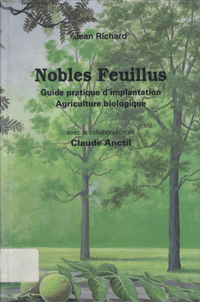 RICHARD, Jean, 1995. Nobles Feuillus, Guide pratique d'implantation Agriculture biologique, Québec: Société d'Horticulture et d'Écologie Jean Richard. 121 p. |
|||
|
Récits floristiques (Français)
|
Un jour, non loin de l'océan Pacifique, une graine minuscule s'est posée sur le sol. De cette graine, un majestueux sapin de Douglas est né. Il a régné sur la forêt pendant 500 ans avant de se coucher au creux du sous-bois pour servir de support aux mousses, aux fougères, aux pruches, les nourrissant de sa propre substance au moment même ou sa vie s'achève. C'est la vie de cet arbre que ce livre raconte. Comme tous ses congénères, cet arbre a tissé des liens riches et complexes avec la communauté des êtres vivants qui l'entourent, depuis les champignons et les lichens, jusqu'au grand pic, à la chouette tachetée, au cougar, au grizzly et au saumon. Ce seul arbre nous relie à l'atmosphère, aux richesses du sous-sol et aux océans. Il nous rappelle les origines de l'univers tout en nous projetant vers l'avenir de la planète. Enfin, en nous racontant son destin, les auteurs font revivre sous nos yeux l'évolution de la botanique et les évènements qui ont marqué pendant tout ce temps l'histoire de l'humanité. Les images évocatrices de Robert Bateman viennent s'ajouter au texte magique de David Suzuki et de Wayne Grady, pour constituer une véritable célébration de la vie. Résumé officiel de la couverture arrière du livre |
|||
|
|||
|
Cet ouvrage convie à une promenade en compagnie de Hubert Reeves et des arbres qui ont compté dans sa vie. Erables, bouleaux, sycomores, ifs, sequoias... souvenirs de la petite enfance ou du matin de printemps, Hubert Reeves évoque sa relation et celle des hommes au monde végétal. Les photographies en noir et blanc de Jacques Véry qui accompagnent le texte de l'astrophysicien n'ont pas pour mission d'illustrer directement les propos de l'auteur, mais de les accompagner dans un lien poétique de l'un à l'autre. Résumé du livre par evene.fr |
|||
|
|||
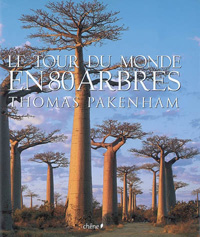 PAKENHAM, Thomas, 2006. Le tour du Monde en 80 arbres, Paris: Éditions du Chêne. 192 p. Passionné par les arbres, et fort du succès international de Meetings with remarkable trees, Thomas Pakenham est reparti traquer, photographier et recenser les champions du règne végétal, cette fois aux quatre coins de la planète. Les textes accompagnant ces magnifiques photographies fourmillent d'informations, de légendes, d'anecdotes et de mythes, dépeignant ces arbres hors du commun, témoins vivants de notre propre histoire depuis plusieurs siècles, voire plusieurs millénaires. L'ouvrage nous présente avec ferveur des spécimens extraordinaires, véritables personnages du règne végétal qui composent une galerie de portraits inoubliables où défilent le "Général Sherman" de la Sierra Nevada, en Californie - le plus gros arbre, voire le plus gros être vivant, au monde -, le cyprès de Tule, au Mexique, qui affiche un tour de taille de 58 mètres, mais aussi "Old Methuselah", un pin de plus de 4 000 ans, ou encore les légendaires baobabs d'Afrique et les plus vieux arbres sacrés du Japon. Résumé de l'éditeur |
|||
|
|||
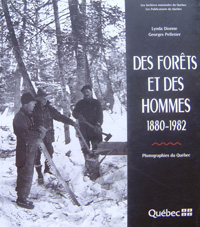 DIONNE, Lynda et PELLETIER, Georges, 1997. Des forêts et des hommes 1880-1982, Sainte-Foy: Les Publications du Québec. 200 p. La forêt a toujours été source de vie. Mais, selon les époques et les différents types d'habitants qui ont occupé le territoire québécois – autochtones, coureurs de bois, colons, explorateurs, immigrants –, son exploitation a connu des hauts et des bas. Aujourd'hui, heureusement, la forêt est considérée comme un patrimoine collectif, et elle demeure l'un des moteurs de l'économie québécoise. Cet album renferme un trésor d'images qui évoquent les différentes étapes de l'exploitation de la forêt québécoise. Elles ont été croquées sur une période de plus de cent ans afin d'immortaliser la vie de nos ancêtres qui ont relevé de prodigieux défis. Résumé de Les Publications Gouvernementales |
|||
|
Récits floristiques (Anglais)
|
The American chestnut was one of America's most common, valued, and beloved trees—a "perfect tree" that ruled the forests from Georgia to Maine. But in the early twentieth century, an exotic plague swept through the chestnut forests with the force of a wildfire. Within forty years, the blight had killed close to four billion trees and left the species teetering on the brink of extinction. It was one of the worst ecological blows to North America since the Ice Age—and one most experts considered beyond repair. In American Chestnut, Susan Freinkel tells the dramatic story of the stubborn optimists who refused to let this cultural icon go. In a compelling weave of history, science, and personal observation, she relates their quest to save the tree through methods that ranged from classical plant breeding to cutting-edge gene technology. But the heart of her story is the cast of unconventional characters who have fought for the tree for a century, undeterred by setbacks or skeptics, and fueled by their dreams of restored forests and their powerful affinity for a fellow species. Their efforts offer hope and inspiration in an era in witch a plant or animal species passes into oblivion every twenty minutes. Résumé officiel du livre |
|||
|
|||
|
Mighty Giants: An American Chestnut Anthology is the inspiring story of an American symbol and the struggle to save it from the brink of extinction, the saga of a unique and exceptional tree that supported a way of life, that fed and sheltered our ancestors, and touched almost every phase of our existence. From Indians and early explorers, to colonists, naturalists, loggers, industrialists, and beyond, from presidents, poets, and artists, including Jefferson, Lincoln, Carter, Thoreau, Frost, Homer, Andrew Wyeth, and many more, the story of our once mighty, towering native chestnut tree is a lesson for our times. It is ultimately a story of how people, working together, can harness the power of community, scientific knowledge, and our growing awareness of the workings of nature to make a difference. With a foreword by Bill McKibben, author of The End of Nature and Deep Economy: The Wealth of Communities and the Durable Future, a leading voice in the growing planetary movement for sustainability and community. The American Chestnut Foundation, a not-for-profit organization dedicated to the re-establishment of the American chestnut tree to its natural range. Résumé officiel de la couverture arrière du livre |
|||
|
|||
|
The American elm, elegant and highly adaptable, was an essential feature of America’s cultural landscape for more than a century, forming great verdant parasols above—and giving its name to—streets all across the nation. The elm became a defining element in the spatial design of America’s villages, towns, and cities, first in New England, and—with the westward transit of Yankee culture—eventually throughout the United States. This fascinating and generously illustrated book traces the elm’s transformation from a fast-growing weed into a regional and national icon, and shows how Elm Street satisfied America’s quest for a pastoral urbanism imagined since the time of Jefferson. Résumé officiel du livre |
|||
|
|||
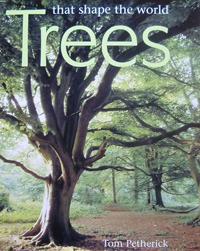 PETHERICK, Tom, 2006. Trees That Shape the World, Londres: Quadrille Publishing Ltd. 192 p. This groundbreaking new book is a detailed and beautifully photographed study of the extraordinary impact of trees on our lives and our surroundings in the past, present and future. In the starkest terms, without trees human life could not survive - they are vital in maintaining the balance of climate and the fragile ecosystems of our planet. Trees provide us with building materials, fuel, food, medicine, shade and protection from the elements. Trees are also the link between the earth and the sky, and for centuries have been revered in many cultures for their links with the past and their spiritual associations. The six chapters in the book look at a different climate zone from the arctic north to the tropical south, describing the native trees in their natural habitat, their relationship and importance to man over the centuries and the part they will play in the future. Within each chapter are features on iconic trees of vital importance to the landscape or to man, looking in detail at their importance in that environment, their spiritual and medicinal uses, the myths and legends that surround them and their many uses. Every continent has its favourite tree that plays a unique role in shaping life: oak, maple, redwood, eucalyptus, olive, apple and mangrove to name but a few. "Trees that Shape the World" will remind readers of the seminal importance of trees - their unique beauty and importance in our world. It is vital that trees are respected and protected, so that we are never again tempted to take them for granted. Résumé officiel du livre |
|||
|
|||
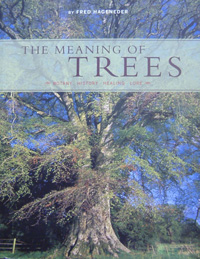 HAGENEDER, Fred, 2005. The Meaning of Trees: Botany - History - Healing - Lore, San Francisco: Chronicle Books. 224 p. The tree is beloved as Mother Nature's visible symbol of power and grace. The Meaning of Trees is a beautiful celebration of their lore and spirit, botany and history. Genera from aspen to willow are captured in 70 dramatic photographs that illustrate their brilliant seasonal transformations. Featuring 50 different types of tree, this informative compendium describes each by way of botanical qualities ; medicinal uses for their leaves, bark, and wood ; cultural symbolism ; magical associations ; and so much more. Fascinating facts abound: the Druids believed that only the wood of the yew tree was fit to make wands ; a Ukrainian tonic of birch leaves contains the same healing properties as aspirin. A visually stunning and engaging guide, The Meaning of Trees is a fitting tribute to this most majestic of natural wonders. Résumé officiel du livre |
|||
|
|||
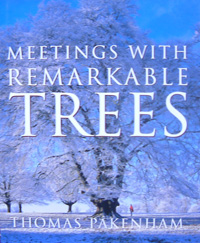 PAKENHAM, Thomas, 2003. Meetings With Remarkable Trees, Londres: Weidenfeld & Nicolson. 192 p. Thomas Pakenham, a distinguished historian of Africa, takes a new tack by writing an old-fashioned kind of book in Meetings with Remarkable Trees: a catalogue of trees of the British Isles. The last such book was published in 1826. In Meetings with Remarkable Trees Pakenham assembles a beautifully photographed gallery of 60-odd trees of Scotland, England and Ireland, and magnificent trees they are. One is a 600-year-old king oak that looms large over Charleville, Ireland ; another is the yew tree that Wordsworth called the "pride of Lorton's vale" ; still another is a sequoia brought from the United States and planted in a Herefordshire grove in 1851, where it has since flourished. Pakenham helpfully includes a map showing the locations of his scattered dramatis personae ; you could make a fine tour retracing his steps and having a look for yourself. Résumé de Christine Buttery, Amazon.com |
|||
|


